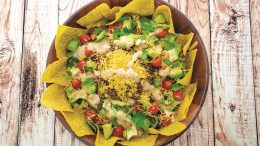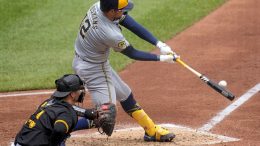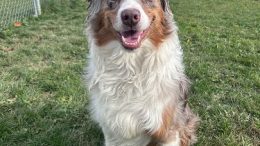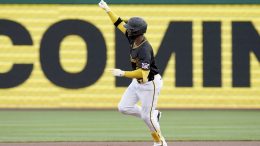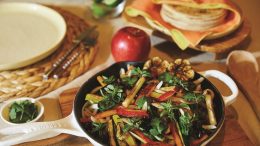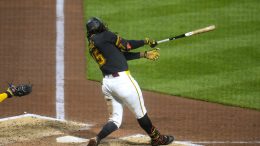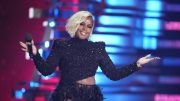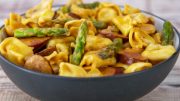Generally, fruit trees are pruned to develop a desired tree shape, to improve fruit quality, and to improve air circulation within the tree, which will reduce the potential for disease.
Excessive pruning encourages excessive shoot growth and reduces the quality of fruit on young trees. Older trees (25 years and older) will produce higher-quality fruit following a vigorous pruning.
Regardless of the type of tree you are pruning, there are only two types of pruning cuts. The first is a heading cut. This type of cut involves shortening a limb or shoot by removing a portion off the end. Heading cuts remove the terminal buds that normally inhibit shoot development from buds below the terminal or end of the shoot. A heading cut results in several shoots developing just below the location of the cut. The number of shoots that develop and the vigor of the growth will depend on the severity of the heading cut. Heading cuts result in a thicker and denser canopy and reduce light levels within the tree.
The second is a thinning cut. A thinning cut is the removal of an entire shoot back to its point of origin. Thinning cuts do not induce excessive vigorous regrowth and open the tree’s canopy to allow more sunlight into the interior. The image above illustrates the growth that occurs when a dormant shoot is not headed, is headed one-third of its length; is headed two-thirds of its length, or is headed to remove all of the previous year’s growth. Note the increase in vigor and reduction in fruiting wood the more severe the cut.
Prune young trees (up to 10 years of age) lightly. Prune older trees more vigorously. Be sure to remove all dead and broken limbs when you prune. Remove sucker growth from the interior of the tree and around the base of the trunk annually. Thinning-out cutting (removing an entire limb or shoot) is associated with increased apple flower bud production. Heading-back cutting (shortening the ends of branches) encourages shoot growth. Remove pruned brush from the orchard area. Dead wood will harbor disease organisms that can spread back into the tree. Burning or burying the prunings is the best practice.
The day you plant your trees is the day you should begin to prune and train for future production. Too often, backyard growers plant apple and pear trees and leave them untended for several years. This neglect results in poor growth and delayed fruiting.
The purpose of pruning a young tree is to control its shape by developing a strong, well-balanced framework of scaffold branches.
Unwanted branches should be removed or cut back early to avoid the necessity of large cuts in later years. Currently, the preferred method of pruning and training nontrellised trees is the central leader system.
Pruning should be done in late winter. Winter pruning of apple trees consists of removing undesirable limbs and tipping terminals to encourage branching. Summer training is most beneficial if done in early June and early August.
First Growing Season
The proper height to cut back the tree at planting is 30 inches. Heading back the tree to this height will bring the top and roots back into balance and cause buds just below the cut to grow and form scaffold branches.
Cutting lower, 24 inches (A) will result in excessive vegetative growth. Cutting too high, 36 inches will result in weak growth in the top of the tree as well as in lower areas.
After a few weeks, trees that are headed may appear as in Figure 4.4A. The shoots are vigorous and upright growing with very narrow crotch angles. To prevent this, you need to force the new shoots to a more horizontal growth pattern. When 2 to 3 inches of growth have occurred, position wooden spring-type clothespins between the main trunk or branch and the new succulent growth. The clothespins will force the new growth outward and upward and form the strong crotch angles needed to support the fruit load in years to come. Allow the most vigorous upright branch to remain growing straight up–this will become the central leader. You should plan to keep approximately four to six of the developing shoots with the goal of having them separated equally around the trunk and arranged vertically within a 4- to 10-inch distance.
It is important that the limbs are spread when they are young. If a limb is not spread as in the picture above, a bark inclusion can develop. This occurs when the bark of the trunk and the branch have been pressed together. This structure weakens the branch and serves as an entry point for pathogens. The wide-angled branch on the right, however, allows for growth and expansion of both the trunk and the branch and produces a much stronger branch that can withstand future heavy crop loads.
One Year Old
A number of branches should have developed after the first growing season; if they were clothes pinned, they should have good crotch angles.
The objective now is to develop a strong central leader and framework of two to three sets of scaffold branches. Remove any broken limbs or limbs growing vertically. Head the central leader about one-third the length of the shoot that grew the first year. Several shoots should develop just below the heading cut. If the first set of scaffolds is vigorous and begins to grow too upright they should be spread through the use of wooden spreaders, weights, or string. Tie or spread the limbs down to a 45- to 60-degree angle.
Second Growing Season
During the second growing season, develop a second layer of scaffolds 24 to 36 inches above the scaffolds you established the year before.
Be sure to clothespin the second level to develop wide crotch angles. Remove any undesirable shoots that are too vigorous or in competition with the central leader during the growing season.
Two Years Old
Limb spreaders can aid in bringing about earlier fruit production, improved tree shape, strong crotch angles, and improved fruit color.
Spreaders can be either short pieces of wood with sharpened nails driven into each end or sharpened metal rods.
Always spread the tree before pruning, which consists of entirely removing undesirable upright limbs and reducing the length of new shoot growth by one-quarter. Limbs should not be spread below a 60-degree angle from the main trunk. Limbs spread wider tend to produce vigorous suckers along the top of the branch and might have reduced terminal growth. The spreaders should remain in place for 1 to 2 years until the branch “stiffens up.”
The objective is to try to leave only four to six main scaffold branches spaced around the tree. A second set of branches above the first is then developed the following year. Always make sure that the ends of the scaffold branches are below the end of the central leader after they have been pruned back.
At maturity the overall appearance of the tree should be a pyramid with the largest and longest branches in the lowest and first set of scaffolds followed by 2 to 3 additional sets that are progressively smaller in diameter and shorter in length.
Three to Four Years Old
Continue to head back the new terminal growth by one-quarter each year and remove any upright limbs.
Any broken or diseased limbs also should be removed. Always maintain the central leader as the highest point on the tree. The ends of the primary and secondary scaffolds should be kept below the top of the tree. Prune the trees every year in late winter (February or March). Keep the leader dominant by shortening competing branches. Remove branches that form narrow crotch angles. Remove weak, twiggy growth.
Succeeding Years
Once the trees begin to bear fruit and no later than when they reach their fifth winter, discontinue heading back the new terminals. Pruning for the rest of the life of the tree will be done to maintain the conical structure.
Remove vigorous upright or downward-growing shoots. A good image to guide your pruning is to try to create two-dimensional scaffold branches. This means the branches will have a single terminal point and will spread out in a triangle back into the center of the tree but will not have any shoots growing up or down. Try to retain only shoots that are horizontal. Periodically thin out the branching structure to allow adequate light to penetrate the interior and lower portions of the tree.
Always maintain the central leader as the highest point on the tree. The ends of the primary and secondary scaffolds should be kept below the top of the tree. Prune the trees every year in late winter (February or March).
Pruning and Training to a Trellis
Trellising is a means of supporting dwarf apple and pear trees to increase their bearing surface and hence their production. The trellis consists of a series of wires supported by posts. Limbs and branches are positioned on this wire fence to encourage fruit production. Varieties on M.27, Bud.9, M.9, or M.26, as well as pears on Quince C rootstock, can be trained to a trellis.
Constructing the Trellis
The trellis should be in place before the trees are planted. In the home orchard, 8-foot posts are driven 2 feet into the ground and spaced every 15 to 20 feet apart depending on the amount of space available and the number of trees to be planted. Four wires spaced 18 inches apart, or three wires (no. 9 galvanized wire or stronger) spaced 24 inches apart are strung across the posts. The wire can be fastened to the posts by fence staples, or 1/4-inch holes can be drilled through the posts and the wire passed through the holes. The top wire can be either stapled to the top of the post or strung through a hole drilled 1 inch below the top. End posts will need additional anchoring using a deadman such as that used on telephone poles.
To train trees to a trellis, start by planting the trees 6 to 7 feet apart between the supporting posts. Plant the first tree 4 feet from the end post. Remember to keep the graft union above the ground. Head the tree off just below the bottom wire and loosely tie it to the same wire. Allow young shoots to develop and loosely tie them to the trellis wire in the spring and early summer. Some shoots will develop that are not in the plane of the trellis (projecting away from the wire). These shoots should be pruned off or bent and tied to the wire so they fit the plane. The shoots should be tied to the trellis so they form a 45-degree angle from the main trunk. Allow one shoot to grow straight up. This will be used to develop succeeding levels of branches.
After the first growing season, prune back the terminals of the tied limbs as well as the central trunk. Remove undesirable limbs. Pruning after the second growing season should be similar to that done after the first season. Your goal should be to fill up the trellis area with limbs before heavy fruiting begins. Remove all fruit during the first 2 years following planting to encourage tree growth. The onset of fruiting will reduce the amount of pruning necessary.
Periodically, limbs get old and production decreases. If a limb starts declining, prune it out by cutting it back to a stub close to the main trunk, and train a new one to take its place. Girdling can result where the limbs and trunk are tied to the wires. Periodically check these ties to make sure that they are still loose and not binding.
Pruning – A Special Case – Renovating Old Fruit Trees
Many people move to new homes where the previous owners had planted fruit trees. If the owner did not properly care for the trees, the results are large ungainly giants that are completely out of control and are an unsightly mess. In other instances, people move into old farmhouses where trees were planted 30 or 40 years ago. These, too, if they have been neglected, are large and difficult to maintain. In many cases, these old trees can be brought back to a more manageable state. The primary means of renovating older trees is through judicious and properly selected pruning cuts. Apple and pear trees are most easily renovated. Cherries also can be renovated, but to a lesser degree and with less success. Peaches and nectarines are not recommended for renovation, and are not considered here. It is easier to cut a peach tree down and plant a new tree.
Several questions should be answered before an attempt is made to rejuvenate an old tree. Is the tree worth saving? Did it formerly bear unique fruit that was exceptionally good for fresh eating or canning? Is the tree structurally sound–do the trunk and main limbs seem capable of bearing a heavy load of fruit, or would they simply break when heavily laden? Is the tree in a suitable location or does it shade the garden or interfere with lawn mowing? Is it full of insects and diseases? These are among the most important issues one should consider before proceeding.
The first step is to examine the trunk and butt ends of the major branches. They should be reasonably sound and free from large areas of dead wood on which the bark has died. Although much of the trunk and parts of the major limbs are nonfunctioning, they do provide structural strength to the entire tree. If the trunk and parts of the major limbs are hollow, efforts to save the tree will most likely be unsuccessful. Areas of branches and the trunk that appear orangish-brown and scaly also are an indication of poor health. A thin green line, visible when the bark is peeled back gently with a pocketknife, indicates a healthy branch and tissue.
If this examination reveals serious structural and health problems, you might be better off vegetatively propagating the tree or ordering a new one of the same variety for planting. Your county extension office has a bulletin titled Grafting and Propagating Fruit Trees (https://extension.psu.edu/fruit-tree-propagation-grafting-and-budding) that explains how to vegetatively save the tree.
If you decide to rejuvenate the tree, prune out all broken and dead branches and cut away the sucker growth around the bottom of the trunk. Once the dead and broken material has been removed, the general form of the healthy portions of the tree can be seen.
The second step is to decide how big you want the tree to be. Realize, however, that you can never make a seedling tree into a dwarf size no matter how much you prune. A true dwarf tree can be maintained at about 6 to 10 feet tall, a semidwarf at about 10 to 16 feet and a standard at about 16 to 20 feet tall. Trees that have not been pruned in many years should not be reduced to the desired height in a single pruning. To prevent excessive growth and excessive sunburn on previously shaded portions of the tree, you should plan on reducing tree height over a period of 3 years by removing no more than one-third of the tree in one season. If, for example, the tree is currently 23 feet tall and you want to bring it back to about 14 feet, lower the overall height by 3 feet per year.
To reduce tree height, selectively cut to branches growing more horizontal to the ground. Thin out excessive branches as well. Do not indiscriminately cut all the shoots in half. Do not “dehorn” the tree, as some people mistakenly do with large shade trees to reduce their height. After the desired height and limb spread have been decided, look closely at the major branches to determine where they could be cut to bring the tree into conformity.
It is important that no nitrogen be applied immediately after the initial heavy cutting. Nitrogen should not be applied because the root system under the tree is large enough to provide water, oxygen, and stored food reserves to all of the aboveground portions of the tree before any cutting was done. In effect, the first year’s pruning means that the same amount of root system is supplying fewer growing points. Adding more nitrogen fertilizer would stimulate excessive vegetative growth that would further complicate next year’s pruning.
The remaining portion of the tree should be protected from insects and diseases to ensure that the fruit produced will be usable and that the tree will form flower buds for next year’s crop. Unfortunately, on tall, large trees it is often difficult to reach the tops. Most small hand sprayers can reach at best 10 to 12 feet up into a tree. It will be difficult, therefore, to control diseases and insects in the larger trees until they have been lowered.
During the summer after the first winter pruning, remove the numerous water sprouts that will grow on the heavily pruned tree. Water sprouts are rapidly growing vegetative shoots that develop around pruning cuts. The method of removal is important. If you use a pruning shears, you can never quite remove the entire shoot. Instead, pull the shoots off the trunk in mid-June when they are about 10 to 12 inches long. Keep pulling these shoots off throughout the season on the major scaffolds. The shoots can be pulled off safely as long as their bases remain tender and green. Stop when the base of the shoot becomes woody and does not easily pull off. Also during this time, or from late May to early June, thin the fruit down to 1 fruit per cluster and space the clusters about 6 to 10 inches apart. This practice will ensure that the remaining fruit will attain the largest possible size.
In the late winter or early spring of the following year, before growth begins, prune the tree again. This time, however, limit the pruning to thinning out the bearing wood. Take time to look carefully at the tree. Notice where the 1- to 4-year-old wood pieces are located. This is important because the best fruit grows only on spurs that are 2 to 3 years old. To promote better flower formation and good light penetration into the tree, separate these bearing surfaces by about 18 to 24 vertical inches from any other layers.
Another way to visualize this type of pruning is to imagine the removal of 65 to 70 percent of the bearing surface. This is accomplished primarily through thinning-out cuts–removing branches back to their point of origin.
Following the last year of rejuvenation pruning, apply a light application of fertilizer. A good rule of thumb is to apply 0.5 pound of 5-10-10 for each inch of trunk diameter, measured 18 to 24 inches above the soil line. Apply fertilizer at any time from December until April. Scatter it under the entire limb spread of the tree, but keep it at least 6 inches away from the trunk.
This educational blog is a series of informative articles from the Penn State Master Gardeners volunteers plus news concerning the group and their activities. For more information, click here.









